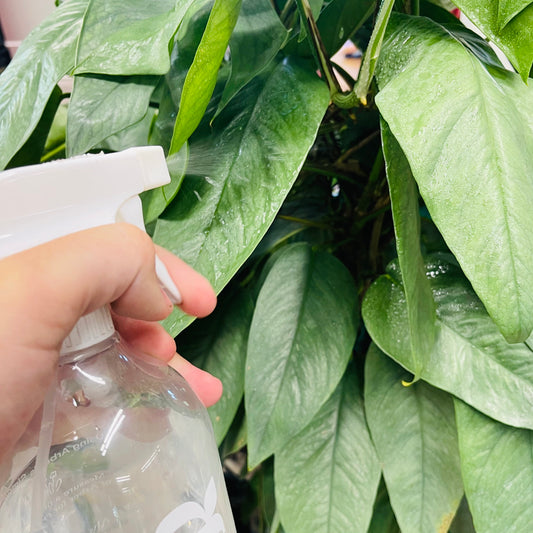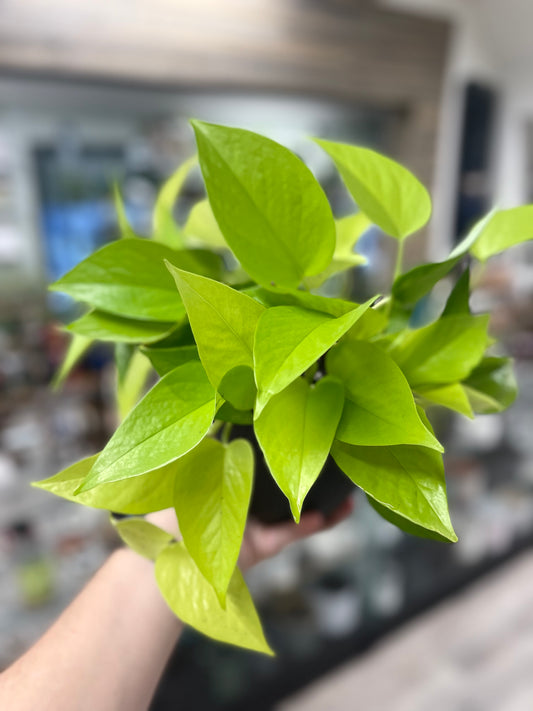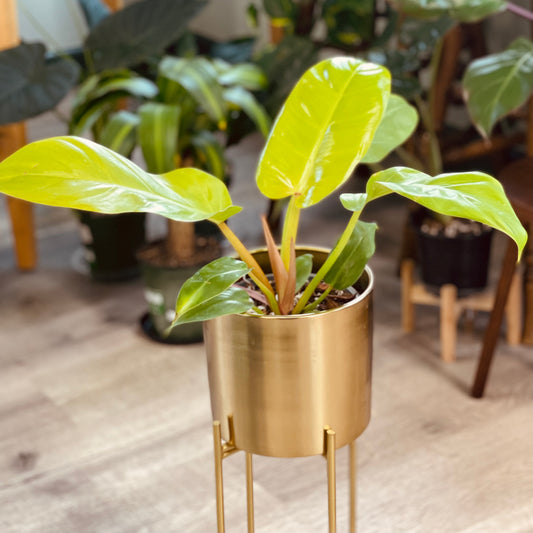Philodendrons are a tropical plant species that are native to South America and are part of the Araceae family. They are known for their lush foliage and are a popular choice for indoor houseplants. With over 4,000 different species, Philodendrons can be found in many different shapes, sizes, and colors. In this article, we will discuss the scientific information about Philodendrons, different types of Philodendrons, watering instructions, lighting instructions, best placement in your house, how and when to use a moss pole or stake, when to consider repotting, when to feed and what type of fertilizer, what types of pests to look out for, what to do about browning leaves, what to do about droopy leaves, and any other miscellaneous information you may need to know about Philodendrons.
Scientific Information
Philodendrons are part of the Araceae family, which is a family of flowering plants that includes other popular houseplants such as the Peace Lily and the Chinese Money Plant. The Philodendron genus is known for its large, glossy leaves and aerial roots. These plants are known as epiphytes, which means they have the ability to grow on other plants or surfaces in their natural habitat. In their native environment, some species of Philodendron can grow as a vine, others as a shrub or even as a tree. These plants have a wide range of leaf shapes and sizes, from small and delicate to large and imposing, that can be smooth, lobed or deeply dissected. They also produce small flowers that are typically green or white, and are typically not showy. These plants are native to tropical regions of South and Central America, from Mexico to Argentina.
Types of Philodendrons
As of September 2015, the World Checklist of Selected Plant Families accepted 489 species of philodendrons. The Heartleaf Philodendron is known for its small, heart-shaped leaves and its ability to climb. The Fiddle-Leaf Philodendron is known for its large, fiddle-shaped leaves and its ability to grow tall. The Elephant Ear Philodendron is known for its large, glossy leaves that resemble elephant ears.
Watering Instructions
Proper watering is crucial for maintaining the health of your Philodendron. These plants prefer to have consistently moist soil, but not waterlogged. A good rule of thumb is to water your Philodendron when the top inch of soil is dry to the touch. A moisture meter can be a useful tool to help you determine when to water, as it will give you a reading of the soil moisture level. If you don’t have a moisture meter, you can use the “finger trick”. Simply insert your finger into the soil up to your first knuckle. If the soil feels dry, it’s time to water. If the soil feels damp, then wait a few days before checking again.
It’s important to use a well-draining potting mix and a pot with drainage holes to help prevent root rot. If your Philodendron is in a pot with drainage holes, make sure to use a saucer and empty it out after watering to ensure that the roots are not standing in water. Overwatering can be just as harmful as underwatering, so be sure to check the soil moisture level regularly and adjust the watering schedule accordingly.
It’s also worth noting that the frequency of watering may vary depending on the size of the pot, the environment and the time of year. During the summer, when the plant is actively growing, it may need watering more frequently, while in the winter, when the plant is dormant, it may need watering less frequently.
Overall, the key to watering Philodendrons is to find a balance between keeping the soil consistently moist and avoiding waterlogging, and the best way to do this is to check the soil moisture level regularly.
Lighting Instructions
Philodendrons thrive in bright, indirect light. They can tolerate low light conditions, but they won't grow as vigorously. To ensure that your plant is getting enough light, place it near a window that receives bright, indirect light during the day.
If the light in your home is not sufficient, you can supplement with LED grow lights. These lights provide a full spectrum of light that mimics natural sunlight, and can be adjusted to provide the right amount of light for your plant. It's important to place the lights close to the plant, but not too close as it may burn the leaves.
It's also worth noting that the lighting needs of your Philodendron may change as the plant matures. Younger plants will require more light than mature plants, so make sure to adjust the lighting accordingly. In general, the more light your Philodendron receives, the more vibrant and healthy it will be.
Overall, it is important to ensure that your Philodendron is getting enough bright, indirect light to thrive. If you are unable to provide enough natural light, supplementing with LED grow lights can be a great option. Be sure to monitor your plant's growth and adjust the lighting as needed to ensure that it is getting the right amount of light for optimal health.
Best Placement in Your House
The best placement for your Philodendron would be in a well-lit room, such as a living room or kitchen. Avoid placing them in drafty or air-conditioned rooms, as this can cause the leaves to dry out. East or West-facing windows are ideal as they provide bright, indirect light for most of the day. South-facing windows may provide too much direct sunlight and can cause leaf burn, while north-facing windows may not provide enough light.
Using a Moss Pole or Stake
Philodendrons are natural climbers and in their natural habitat, they use aerial roots to climb on other plants or surfaces. As indoor houseplants, they can become too tall or leggy, which can cause them to lose their shape and aesthetic appeal. Using a moss pole or stake can help support your Philodendron and encourage new growth.
When using a moss pole or stake, it is important to tie the stem of the plant securely to the pole or stake with a piece of string or twine. This will help the plant to grow upright and will also encourage new growth. As the plant grows, it will naturally cling to the pole or stake using its aerial roots.
Moss poles are commonly used in conjunction with Philodendrons as they provide a natural and organic support for the plant to climb. Moss poles are generally made from natural materials, such as bamboo or wood, and are wrapped with sphagnum moss. The moss helps to retain moisture and provides a suitable surface for the aerial roots to cling to.
When using a moss pole or stake, it's important to keep in mind that they do require regular maintenance. The moss needs to be kept moist and may need to be replaced periodically. It's also important to check the plant's ties occasionally to make sure they are secure but not to the point that they are causing any damage to the stem.
Repotting
When it comes to repotting, your Philodendron will need to be repotted when it becomes root-bound, which usually occurs every one to two years. Use a well-draining potting mix and a pot that is slightly larger than the previous one. Be sure your new pot has drainage holes to allow excess water to run through the soil to prevent over watering.
Fertilizing
You can feed your Philodendron every four to six weeks during the growing season, using a balanced, water-soluble fertilizer. Avoid fertilizing during the winter, as the plant will be dormant.
Pest Control
Common pests to look out for include spider mites, mealybugs, and scale insects. These pests can be controlled with insecticidal soap or neem oil. Be sure to regularly inspect your plant for any signs of infestation, such as small webs or sticky residue on the leaves.
Browning Leaves
If you notice that the leaves of your Philodendron are browning, it could be due to a number of factors, including too much direct sunlight, dry air, or underwatering. To fix this, simply adjust the lighting and watering accordingly. Make sure to keep the plant out of direct sunlight and keep the soil consistently moist.
Droopy Leaves
If your Philodendron's leaves are drooping, it could be a sign of underwatering or a lack of humidity. Increase the frequency of watering and mist the leaves with water to increase humidity. You can also place a humidifier nearby or use a pebble tray to increase humidity.
Pet Safety
While Philodendrons are popular houseplants, they can be toxic to pets if ingested. The leaves and stem of the plant contain a toxic substance called calcium oxalate. If a pet ingests this substance, it can cause burning or irritation of the mouth, tongue, and lips, as well as difficulty swallowing and vomiting.
It is important to keep Philodendrons out of reach of pets, especially if you have cats or dogs that are known to chew on plants. If you notice your pet has ingested a Philodendron, it is important to seek veterinary attention immediately.
It's also worth noting that some species of Philodendron have been known to cause skin irritation in some people and animals, so it is important to handle them with gloves and to wash your hands thoroughly after handling.
If you have pets and would like to have a plants in your home, it's best to opt for a pet-safe alternative such as snake plant, Pothos, or Spider plant. These plants are non-toxic to pets and can add a touch of green to your home without posing a risk to your furry friends.
Conclusion
With proper care and attention, your Philodendron will thrive and bring a touch of the tropics to your home. Remember to keep the soil consistently moist, provide bright, indirect light, and watch out for pests. With a little bit of love and care, your Philodendron will be a beautiful addition to your home for years to come.





![Dracaena marginata (16" Plastic Pot) [ID #47618480]](http://zenrockford.com/cdn/shop/files/image_992491d2-6277-4893-842f-11e2983f137e.jpg?v=1725732294&width=533)
![Philodendron Florida Bronze (10" Nursery Pot) [ID #29432345]](http://zenrockford.com/cdn/shop/files/image_a67d0fb6-348e-4829-a7eb-64ce015a3b39.jpg?v=1725643115&width=533)
![Aglaonema Manilla's Pride (3" Plastic Pot) [ID #33051624]](http://zenrockford.com/cdn/shop/files/image_1fb45f38-7b6b-412c-aa29-ed2df326d106.jpg?v=1753291075&width=533)
![Scindapsus Silver Lady (8" Clay Pot w/ Moss Pole) [ID #47128926]](http://zenrockford.com/cdn/shop/files/image_f5c79dcd-5dd4-4ba3-9cf7-f49da779e5ea.jpg?v=1726510803&width=533)